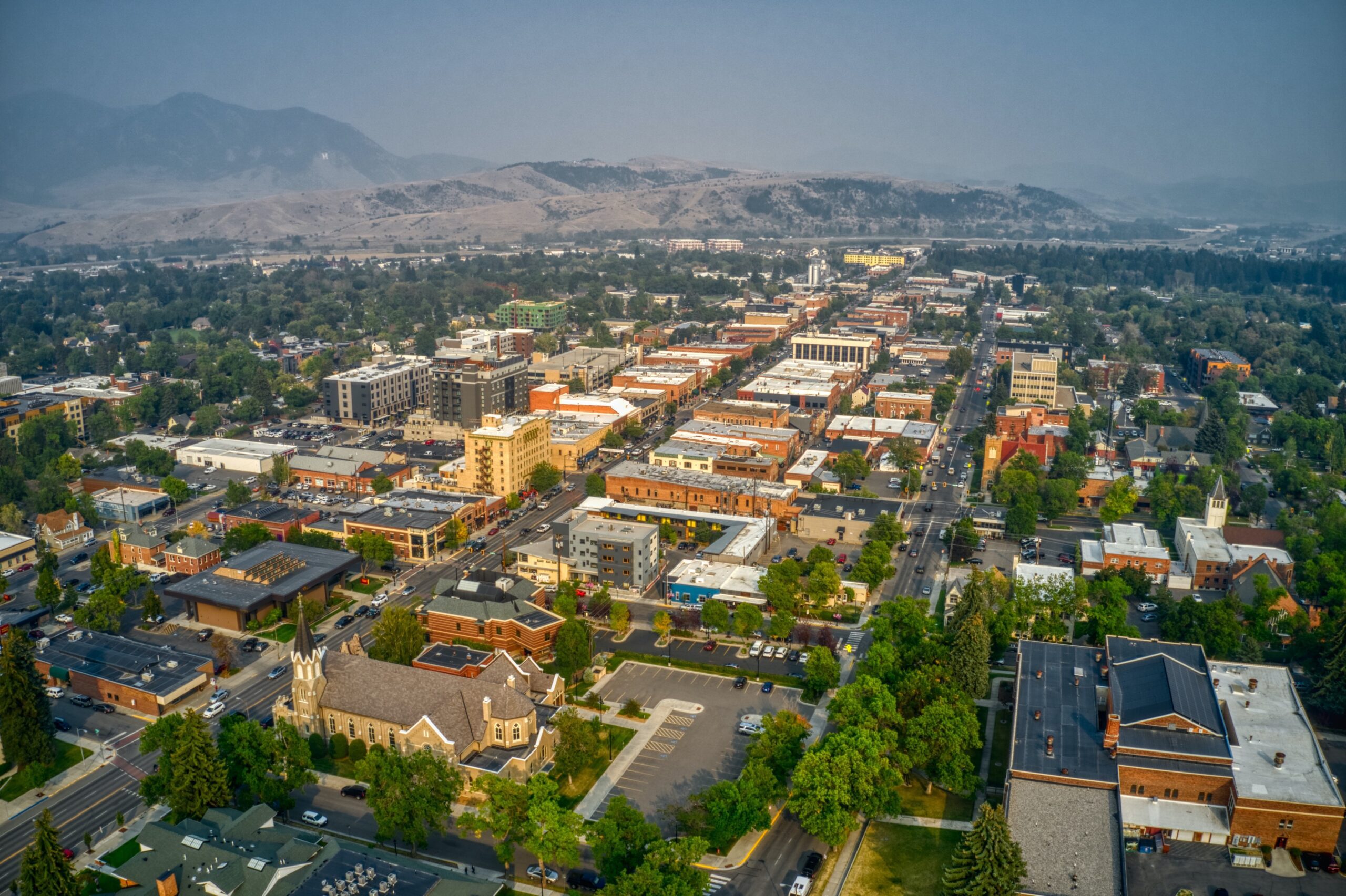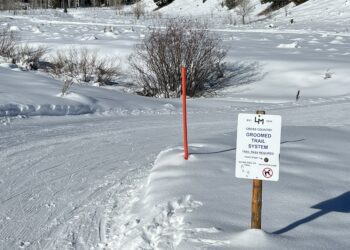Buyers and sellers facing a ‘Western standoff’ in Bozeman, Big Sky approaching equilibrium
By Jack Reaney STAFF WRITER
It’s no 2021 or 2022, but so far, 2023 is Bozeman’s third-highest grossing year for single-family home sales.
In other words, Bozeman’s real estate market appears to have pulled through COVID stronger than before.
As interest rates have made homeowners reluctant to sell, Bozeman faces a low inventory of single-family homes for sale. Since the beginning of April, homes listed are averaging just 11 days on the market before they sell for over 98% of asking price—the April median was $866,085 across 54 sales—according to data from Multiple Listing Service, provided to EBS by Outlaw Realty.
Outlaw Realty is affiliated with Outlaw Partners, the publisher of Explore Big Sky.
Bozeman condos and townhomes aren’t too different. They’re selling in seven days, at above asking price with a median of $500,000 across 28 sales in April.
EJ Daws is a fourth generation Bozemanite, and has been a broker with Outlaw Realty for nearly eight years. He told EBS the decade following the Great Recession has been extreme, either booming or stagnant. Especially since COVID, people relocating to southwest Montana have kept supply low, he said, and the relationship between price growth and population has looked like a “hockey stick curve.”
The median single-family home price in Bozeman has more than doubled since 2017, according to the Gallatin Association of Realtors’ 2023 Gallatin Valley Housing Report.
“The word is definitely out on this part of the country,” Daws said. “It’s easy to get [here] and people enjoy the lifestyle.”
From his perspective, many transactions now face “an old Western standoff between buyers and sellers.”
As buyers see for-sale inventory increasing, they’re waiting for sellers to budge on pricing, Daws explained. But sellers recognize they might not need to compromise.
“Sellers are sometimes reluctant to trade the [lower] interest rate they have right now for a 6.5% interest rate which may not allow them to buy something the same or better [staying in this local market],” he said.
He pointed out that for Bozeman condos and townhomes, 46% of April 2023 transactions have been done with cash or tax-deferred 1031 exchange—those loan-free buyers may not be as concerned about interest rates, so there’s no lack of demand in the market.
Mike Magrans, chief investment officer at Outlaw Real Estate Partners—the development-focused affiliate of Outlaw Realty—agreed with Daws’ reasoning that high interest rates are limiting market inventory. But Magrans suggested another reason homes aren’t selling:
“It could be that people are happy here,” he offered. “They moved here, maybe from California, New York, Chicago—and they love it.”
Magrans spoke with EBS after flying back from Toronto, where he attended a real estate conference with the Urban Land Institute, filled with thousands of developers from across the globe. There, Magrans was peppered with questions from industry cohorts curious about Bozeman: the airport, university, infrastructure investments and sustainability of Bozeman’s real estate momentum.
“I will tell you that Montana is still a very attractive and exciting, interesting place for people to invest in and develop,” Magrans said. “It’s definitely on the map now, nationally. I left [Toronto] feeling like we’re going to continue seeing a lot of growth… The rest of the world has got their eyes on us.”
The permanence of a ‘COVID crush’
Aside from interest rate pressure and low inventory, Magrans sees two main trends keeping prices high in the Bozeman market.
“The largest trend impacting our market is that hybrid work and remote work are continuing to make Bozeman a very attractive place to live,” Magrans said. “Particularly for fully remote people who can work anywhere, they want access to the outdoors and the quality of life Bozeman is known for.”
That said, he believes Bozeman’s remote-working population gained during COVID is sustainable, and that future population growth will be sustainable too, as people flock to the Gallatin Valley and decide to stay.
Magrans said the strong market isn’t surprising, and he’s been happy to see the amount of capital being spent on infrastructure in Bozeman—about a billion dollars in the next decade, he estimates—which is helping the city keep up with population growth.
“It should allow for a sustainable amount of growth over the next 20 years, in which the population should double,” he said. He sees Bozeman growing up to match Bend, Oregon and Boise, Idaho—much larger outdoor-oriented cities which experienced growth spurts in the late 1990s, per census data.
“Another [trend] is leisure travel is extremely strong,” Magrans added. “Even though international [travel is] opening up, people are traveling to Montana. They want to see the sights and experience the Montana lifestyle.”
This winter, Time Magazine listed Bozeman as one of the 50 “World’s Greatest Places” and called it an up and coming “Rocky Mountain hub” that used to be “a skip-over town for Yellowstone country.”
“The amount of advertising and PR dollars that’s being spent on Bozeman will only drive more growth, more visitation… [More] interest, eyeballs and buyers of real estate,” Magrans said.
The TV series “Yellowstone,” popular since 2018, has also played a huge role in putting Montana and Bozeman on the map—“Yellowstone” has taken local blame for culture shifts and soaring housing prices, but also received credit for bringing hundreds of millions of dollars and thousands of jobs into the state economy, through production spending, tourism and other industries, according to a University of Montana study.
Daws said he’s seen some interesting twists and turns in Bozeman with boom cycles and the recent “COVID crush.”
Now, as both prices and pending sales are increasing before a typical faster-paced summer, Daws said fair-priced estates are going fast, often with multiple offers being made all at once.
“You can’t wait,” he said. “You have to act with urgency. Because there is value to getting in first. I tell my buyers, have everything ready, so we can move quick.”
As for land transactions, there’s a stark drop-off between land prices within Bozeman proper and beyond—Daws said the current timeline for building homes is keeping most buyers uninterested in “raw ground” mostly found beyond city limits.
“Construction and labor cost is still relevant—it’s not as crazy as it was during COVID, but it’s expensive,” Daws suggested. The Gallatin Association of Realtors’ 2023 Gallatin Valley Housing Report shows that the sale price of newly built single-family homes, condos and townhomes have roughly doubled since 2019.
He added that land anywhere in the Gallatin Valley is expensive, and with the added costs of design and construction, many buyers can get better value by purchasing an existing home.
“But it also comes down to patience—people don’t want to wait 18 months [to move here],” Daws said.
Big Sky finding balance
In Big Sky, recent MLS data shows a slower pace. But “slow” might understate a market where single-family home prices are hovering near $3 million—that’s excluding luxury properties within Big Sky’s private clubs: Yellowstone, Spanish Peaks and Moonlight.
Unlike Bozeman, homes are sitting on the market for weeks. In April, only two single-family homes sold, after sitting on the market for an average of 69 days. Home prices aren’t wavering from peak highs, but the condo and townhome market is shifting toward buyers, according to an Outlaw Realty report.
Five condos sold in April for a median price of $875,000, after averaging more than four months on the market, according to MLS data included in that report.
Michael Pitcairn, a broker with Outlaw Realty for five years, told EBS that Big Sky home buyers are becoming more patient.
“The frenzy to jump into a property quickly—that frenzy is over. We’re just finding more discerning buyers. I’d say pricing across the board has dropped about 10-15% [in Big Sky]… and we’re seeing sellers that are more willing to negotiate,” Pitcairn said.
He was careful not to describe the Big Sky market as buyer-oriented but countered that it’s really just approaching equilibrium after a few wild years. That means a fair buying and selling process, he added.
“I think it’s an exciting time for buyers to get in the market,” he said. “You have time to make educated buying decisions, and you don’t have to rush through the process. You get adequate time to complete necessary due diligence on properties.”
He also observed that shoulder seasons are feeling shorter every year as second-homeowners decide to spend more time in Big Sky. He said most transactions in this market deal with second homes, a key difference from Bozeman.
Pitcairn acknowledged that housing is a challenge for many folks who live and work in Big Sky.
“I’m excited by the new workforce developments that are [being] built to help create housing in Big Sky for the everyday person,” Pitcairn said.
Recent in-house workforce housing construction by Lone Mountain Land Company and Big Sky Resort, and public-private construction partnerships and programs led by the Big Sky Community Housing Trust are moving the needle to enable affordable renting and deed-restricted workforce ownership in Big Sky’s high-priced market. Big Sky faces a space constraint, too: just three land parcels sold between February and April, ranging in price-per-acre from $360,691 to $2.7 million.
The GAR’s 2023 report states in its conclusion that as housing affordability deteriorates in the Gallatin Valley—and Big Sky, to the extreme—“the challenge in Gallatin County is especially daunting.
“Yet it is important to note that the strong economic growth that has pressured housing markets also brings resources to help address the issues that strong growth produces,” the report states, adding that economic decay could be a worse alternative—albeit with lower priced real estate.
Some truth to that statement can be seen in Big Sky: strong business performance, steady Resort Tax collection on luxury goods, and a dose of philanthropy are enabling construction of workforce housing on land which could likely host more profitable units. The payoff will be a more sustainable workforce and year-round community in Big Sky as the seasonal destination expects continued growth in population and notoriety.
These real estate market snapshots reflect a clear trend: moving beyond the immediate impacts of Covid, people want to live and own property in Gallatin County. And even with historic interest rates, sale prices show that enough are willing and able to pay top dollar.











